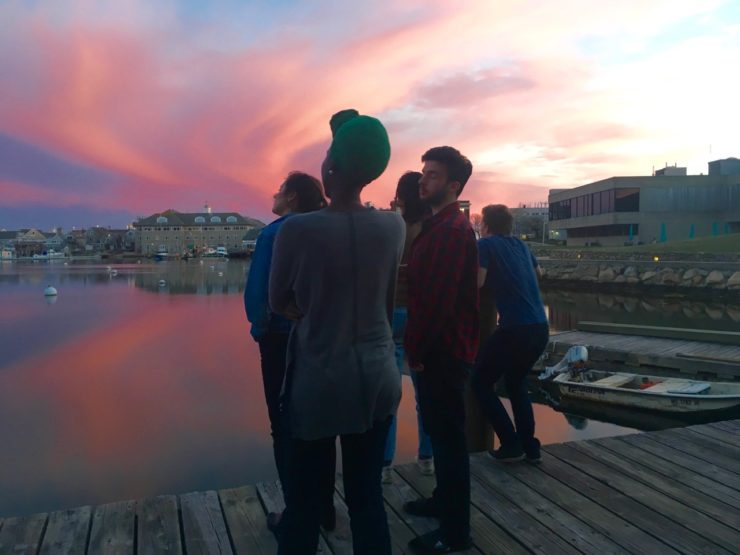
Sunset on Cape Cod during the nine-week Transom program.
Empathy is one of the greatest gifts a journalist can have. If you come by it naturally, you can actually feel what your subject is feeling, and that can be a painful burden sometimes. But even if you have to develop the empathetic wavelength, it not only makes the person you’re interviewing feel understood, it elevates your writing.
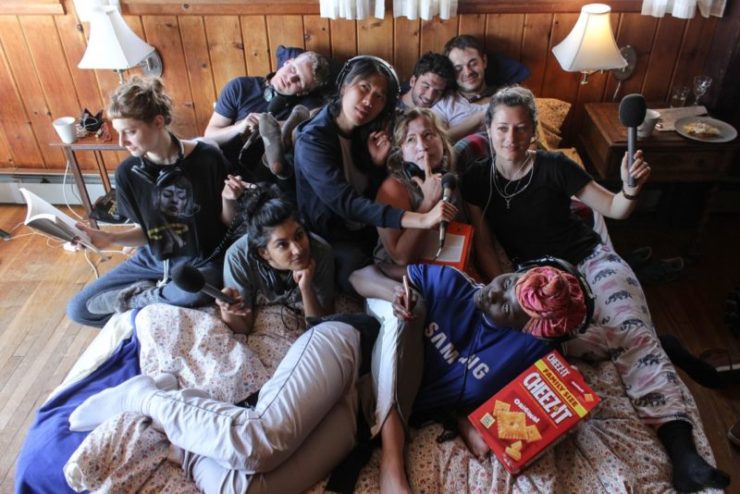
"We were nine students, all younger than 30 – except me."
How a midcareer print reporter mastered the “magic stick” at a 9-week radio Hogwarts. I’ve known and respected Lee Romney for years, and when I heard she was enrolled in a nine-week immersion program to make the transition from lifelong print reporter to radio journalist, I knew her experience would be valuable to Storyboard readers. She says: “In my reporting career, which has gravitated toward people who aren’t often heard, I’ve tried to get out of my own way in my writing to let my subjects speak. Audio, with its raw intimacy, seemed a perfect next step.”
The soundtrack: “Radio, Radio,” by Elvis Costello. I almost chose “Video Killed the Radio Star,” because it must be such sweet revenge for audio fans to witness the rise of podcasts and the newfound appreciation for listening over watching. But come on, Elvis always wins. Such a great opening line: “I was tuning in the shine on the late night dial/Doing anything my radio advised.”
One Great Sentence
“In his blue gardens men and girls came and went like moths among the whisperings and the champagne and the stars.”
F. Scott Fitzgerald, “The Great Gatsby.”
Read why we think it’s great.
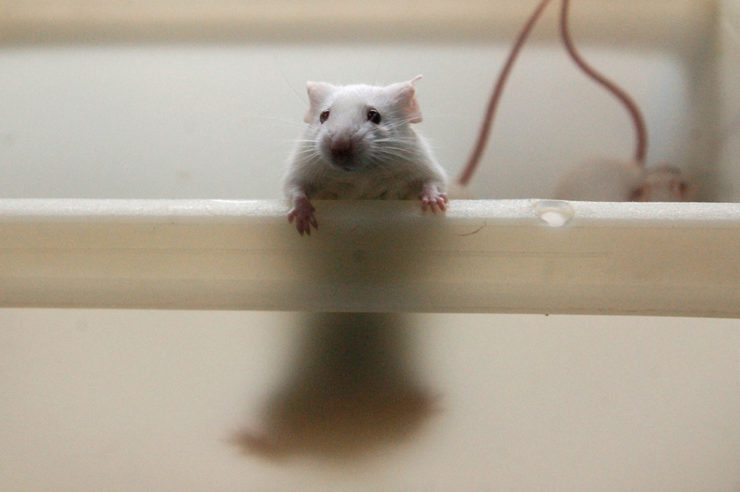
A mouse looks on at an Argentine laboratory.
Maud Newton and the science-meets-personal-essay “I, Rodent.” One fun thing about Storyboard is that it’s not all about what’s new-new-new. Sometimes it’s cool to spotlight classics of literary journalism, or stories that came out a few years back and haven’t lost their ability to touch the reader. Maud Newton’s “I, Rodent” essay for the Awl is one of the latter. In it, she weaves a personal essay with snatches of reporting on the uneasy questions raised by genetic engineering. Here, she talks about the power of empathy and writing hybrid stories like this one: “Increasingly I tend to write nonfiction that jumbles up my own experiences with universal problems.”
The soundtrack: “Dashboard,” by Modest Mouse. This song could have easily been the soundtrack to the radio story above, but I chose it for this post because of the band’s name. I got into them when beloved Smiths guitarist Johnny Marr joined the band. I love the rhythm of the title of the album this song is on: “We Were Dead Before the Ship Even Sank.”
What I’m reading online: “Elemental Haiku,” by Mary Soon Lee. This is my favorite read of the week. How many things out there combine science, poetry, graphics and clickability? In this piece for Science magazine, Lee wrote haikus for every element in the periodic table. I clicked on them all, and the one for magnesium haunts me: “Child of aging stars/No matter how brightly you burn/They will not return.”
“Neither bills nor advancing age can dim the glow of a drummer’s dream.” Steve Lopez is a wonderful columnist for my old paper, the Los Angeles Times. For this piece, we have a dream team of beautiful storytellers, because he’s joined by photographer Francine Orr. I talked about empathy above; Francine is one of the most empathetic photographers I’ve ever worked with. Find her work and be moved.
When The New Yorker tweeted out a Lillian Ross story from their archives the other day, I thought it was going to be one of her famous ones, like the interview with Hemingway. Then I saw the title: “The Shit-kickers of Madison Avenue.” Then I saw the date: 1995. She wrote this eavesdroppy story about self-conscious privileged teens when she had already been at the magazine for 50 years. I’m in awe. (Note: I first typed the title as “Shitkickers.” Glad to see that The New Yorker style gurus made a decision on the word and deemed it hyphenated.)
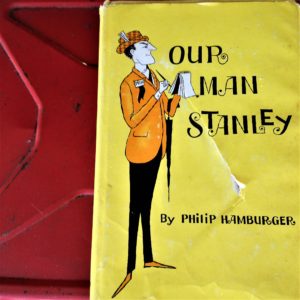 What’s on my bedside table: “Our Man Stanley,” by Philip Hamburger. Keeping with the vintage New Yorker vibe, I picked this up at the local used bookstore for the illustration on the cover alone. (Note the helpful “PRESS” tags on him. A little dangerous to wear these days?) This is a collection of pieces by the fictional reporter “Our Man Stanley” that ran in The Talk of the Town feature in The New Yorker for years. Hamburger writes in the intro: “I am a writer, not an actor, but I love to play Stanley. When I put on one of my Stanley hats and head off to a Presidential Inauguration or a Staten Island ferry ride … I feel free and gay and full of beans.”
What’s on my bedside table: “Our Man Stanley,” by Philip Hamburger. Keeping with the vintage New Yorker vibe, I picked this up at the local used bookstore for the illustration on the cover alone. (Note the helpful “PRESS” tags on him. A little dangerous to wear these days?) This is a collection of pieces by the fictional reporter “Our Man Stanley” that ran in The Talk of the Town feature in The New Yorker for years. Hamburger writes in the intro: “I am a writer, not an actor, but I love to play Stanley. When I put on one of my Stanley hats and head off to a Presidential Inauguration or a Staten Island ferry ride … I feel free and gay and full of beans.”
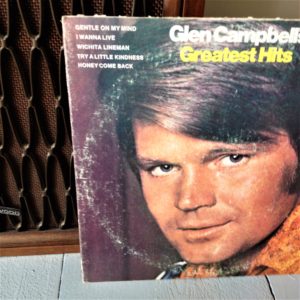 What’s on my turntable: “Glen Campbell’s Greatest Hits.” I’m sure I wasn’t the only one listening to some Glen Campbell this week. I’ll say it loud and say it proud: “Wichita Lineman” is one of my favorite songs. That’s mostly for the lyrics by Jimmy Webb, who is one of the most gifted storytelling songwriters out there, but Campbell’s sweet voice is what drew everyone in. (Also recommended: “I’ll Be Me,” the documentary about Campbell and his struggle with Alzheimer’s.”)
What’s on my turntable: “Glen Campbell’s Greatest Hits.” I’m sure I wasn’t the only one listening to some Glen Campbell this week. I’ll say it loud and say it proud: “Wichita Lineman” is one of my favorite songs. That’s mostly for the lyrics by Jimmy Webb, who is one of the most gifted storytelling songwriters out there, but Campbell’s sweet voice is what drew everyone in. (Also recommended: “I’ll Be Me,” the documentary about Campbell and his struggle with Alzheimer’s.”)
If you want to chat about storytelling (or music), I’m Storyboard editor Kari Howard, and you can reach me at editor@niemanstoryboard.org. Or you can find me at @karihow on Twitter.


